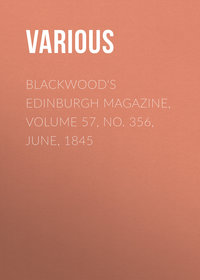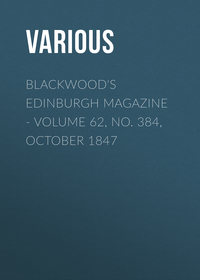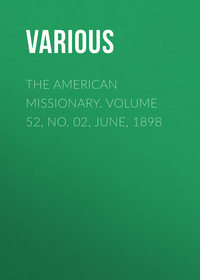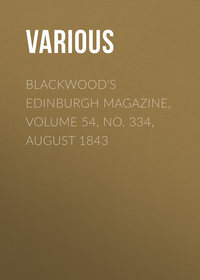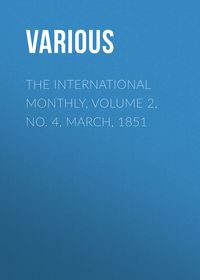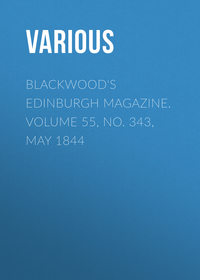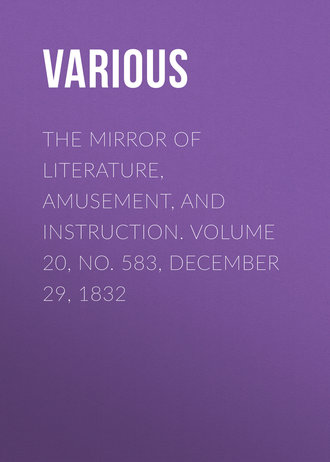 полная версия
полная версияThe Mirror of Literature, Amusement, and Instruction. Volume 20, No. 583, December 29, 1832

Various
The Mirror of Literature, Amusement, and Instruction / Volume 20, No. 583, December 29, 1832
NATURAL TUNNEL, IN VIRGINIA
Rock Bridges occupy the same pre-eminence amongst the sublimities of nature, that artificial bridges maintain amidst the labours of man. Both alike inspire us with admiration, though we are enabled to obtain but unequal results as to their respective origins. The bridge, built by human hands, is, indeed, a triumph of the perfection of skilful contrivance; the strength and beauty of the arch are among the most simple yet exquisite results of science, wonderful as they may appear to the untaught beholder: but how shall we explain the formation of stupendous rock-arches across deep ravines and rolling torrents, in countries where none but the wild and picturesque forms of nature rise to gladden the eye and heart of the inquiring traveller? Of the latter description are the natural bridges which abound in the State of Virginia; as Rockbridge, which gives name to the county in which it is situated, and the wild and fantastic bridges of Icognozo; all of which are more extensively recognised among the wonders of creation than the specimen here presented to the reader.
This Tunnel is in Scott county, Virginia; but was so little known beyond its immediate neighbourhood, as to induce Lieut.-Col. Long, (U.S. Army,) to communicate its description to Mr. Featherstonhaugh's American Journal of Geology and Natural Science; and the following narrative of the Colonel's Excursion will be read with interest:—
"During the past summer, I visited a remarkable natural bridge in Scott county, Virginia, to which I have given the name of Natural Tunnel, on account of its striking resemblance to artificial structures of that kind.
"The immediate locality of this tunnel is upon a small stream called Buck-eye, or Stock Creek. This last name owes its origin to its valley having been resorted to by the herdsmen of the country, for the attainment of a good range, or choice pasture-ground, for their cattle. The creek rises in Powell's mountain, and is tributary to Clinch river, which it enters at the distance of between two and three miles below the tunnel. The aspect of the surrounding country, and especially of that to the northward of the tunnel, and constituting the southerly slope of the mountain just mentioned, is exceedingly diversified, and broken by elevated spurs and ridges, separated from each other by deep chasms, walled with cliffs and mural precipices, often presenting exceedingly narrow passes, but occasionally widening into meadows or bottoms of considerable extent. The mural precipices just mentioned occur very frequently, bounding the valleys of the streams generally in this part of the country, and opposing ramparts of formidable height, and in many places utterly insurmountable. Such are the features peculiarly characteristic of Wild Cat Valley, the Valley of Copper Creek, of Powell's and Clinch rivers, and of numerous other streams of less note, all of which are situated within a few miles of the Natural Tunnel.
"To form an adequate idea of this remarkable and truly sublime object, we have only to imagine the creek to which it gives a passage, meandering through a deep, narrow valley, here and there bounded on both sides by walls, or revetements, of the character above intimated, and rising to the height of two or three hundred feet above the stream; and that a portion of one of these chasms, instead of presenting an open, thorough cut from the summit to the base of the high grounds, is intercepted by a continuous unbroken ridge, more than three hundred feet high, extending entirely across the valley, and perforated transversely at its base, after the manner of an artificial tunnel, and thus affording a spacious subterranean channel for the passage of the stream.
"The entrance to the Natural Tunnel on the upper side of the ridge is imposing and picturesque in a high degree; but on the lower side the grandeur of the scene is greatly heightened by the superior magnitude of the cliffs, which exceed in loftiness, and which rise perpendicularly—and, in some instances, in an impending manner—two or three hundred feet; and by which the entrance on this side is almost environed, as it were, by an amphitheatre of rude and frightful precipices.
"The observer, standing on the brink of the stream, at the distance of about one hundred yards below the debouchure of the Natural Tunnel, has, in front, a view of its arched entrance, rising seventy or eighty feet above the water, and surmounted by horizontal stratifications of yellowish, white, and grey rocks, in depth nearly twice the height of the arch. On his left, a view of the same mural precipice, deflected from the springing of the arch in a manner to pass thence in a continuous curve quite to his rear, and towering in a very impressive manner above his head. On his right, a sapling growth of buck-eye, poplar, linden, &c., skirting the margin of the creek, and extending obliquely to the right, and upward, through a narrow, abrupt ravine, to the summit of the ridge, which is here and elsewhere crowned with a timber-growth of pines, cedars, oaks, and shrubbery of various kinds. On his extreme right is a gigantic cliff, lifting itself up, perpendicularly from the water's edge, to the height, of about three hundred feet, and accompanied by an insulated cliff, called the Chimney, of about the same altitude, rising, in the form of a turret, at least sixty feet above its basement, which is a portion of the imposing cliff just before mentioned.
"Desirous of illustrating this paper by a front view of the Natural Tunnel where the creek issues from it, I have, with the assistance of a particular friend in this city—to whom I am indebted for the accompanying drawing1—been enabled to furnish a sketch which very faithfully represents some of the appearances I have described. The embellishments last mentioned, however, viz. the chimney and its accompaniments, could not be comprised in the landscape.
"The following passages are from my own private journal:—
"Saturday, Aug. 13, 1831. Having ascended Cove ridge, we turned aside from our route to visit the natural bridge, or tunnel, situated on Buck-eye, or Stock creek, about a mile below the Sycamore camp,2 and about one and a half miles from a place called Rye cove, which occupies a spacious recess between two prominent spurs of Powell's mountain, the site of the natural tunnel being included within a spur of Cove ridge, which is one of the mountain spurs just alluded to. Here is presented one of the most remarkable and attractive curiosities of its kind, to be witnessed in this or any other country. The creek, which is about seven yards wide, and has a general course about S. 15 W., here passes through a hill elevated from two to three hundred feet above the surface of the stream, winding its way through a huge subterraneous cavern, or grotto, whose roof is vaulted in a peculiar manner, and rises from thirty to seventy or eighty feet above its floor. The sides of this gigantic cavern rise perpendicularly in some places to the height of fifteen or twenty feet, and, in others, are formed, by the springing of its vaulted roof immediately from its floor. The width of the tunnel varies from fifty to one hundred and fifty feet. Its course is that of a continuous curve, resembling the letter S; first winding to the right as we enter on the upper side, then to the left, again to the right, and then again to the left on arriving at the entrance on the lower side. Such is its peculiar form, that an observer, standing at a point about midway of its subterranean course, is completely excluded from a view of either entrance, and is left to grope in the dark through a distance of about twenty yards, occupying an intermediate portion of the tunnel. When the sun is near the meridian, and his rays fall upon both entrances, the light reflected from both extremities of the tunnel contributes to mollify the darkness of this interior portion into a dusky twilight.
"The extent of the tunnel, from its upper to its lower extremity, following its meanders, is about 150 yards; in which distance the stream falls about ten feet, emitting, in its passage over a rocky bed, an agreeable murmur, which is rendered more grateful by its reverberations upon the roof and sides of the grotto. The discharge of a musket produces a crash-like report, succeeded by a roar in the tunnel; which has a deafening effect upon the ear.
"The hill through which this singular perforation leads, descends in a direction from east to west, across the line of the creek, and affords a very convenient passage for a road which traverses it at this place, having a descent in the direction just mentioned of about four degrees.
"The rocks found in this part of the country are principally sandstone and limestone, in stratifications nearly horizontal, with occasional beds of clay slate. A mixture of the two former frequently occurs among the alternations presented by these rocks. A variety of rock resembling the French burr occurs in abundance on Butcher's-fork of Powell's river, about twenty miles northwardly of the Natural Tunnel. Fossils are more or less abundant, in these and other rocks. Fossil bones, of an interesting character, have been found in several places. Saltpetre caves are numerous. Coves, sinks, and subterranean caverns, are strikingly characteristic, not only of the country circumjacent to the Natural Tunnel, but of the region generally situated between the Cumberland mountain, and the Blue ridge or Apalachian mountain. Bituminous coal, with its usual accompaniments, abounds in the northerly parts of this region; and in the intermediate and southerly portions, iron, variously combined, often magnetic, together with talcose rocks, &c. &c. are to be met with in great abundance.
"The mountains in this vicinity—long. 82° to 84° W. from Greenwich, lat. 35° to 36° N.—are among the most lofty of the Allegheny range. Several knobs3 in this part of the range, among which may be enumerated the Roan, the Unaka, the Bald, the Black, and Powell's mountains, rise to the height of at least four thousand five hundred feet above tide."
Mr. Featherstonhaugh remarks, that the Natural Tunnel has not been worn through the rock by the long-continued action of running water is evident, not from the cavernous structure alone of the general country, but from the form of Powell's mountain, in a spur of which the Tunnel passes transversely.
Mr. Featherstonhaugh further concludes the Tunnel to be a natural cavity in the rock, for, if such had not been the case, "it is evident that the stream would have been deflected from its line; would have followed the base of the hill, and have turned the extreme point."
Little is known of the geology of the country in which this Tunnel is situate, notwithstanding the popularity of the natural bridges of the State. The rock before us would appear to belong to that class which geologists commonly term Perforated Mountains, which some suppose to have been bored through, in part, at least, by the persevering industry of man. "Such phenomena," observes Maltebrun, "are, however, mere eccentricities of nature, and differ from caverns only from the circumstance of having a passage entirely through them. The Pierre-Pertuise in Mount Jura, and Pausilippo, near Naples, are instances of this kind. The Torghat, in, Norway, is pierced by an opening 150 feet high, and 3,000 long. At certain seasons of the year, the sun can be seen darting its rays from one extremity to the other of this vault. Near New Zealand is a rocky arch through which the waves of the sea pass at high water."4 The latter, one of the Piercy Islands, will be found engraved and described in The Mirror, vol. xix. p. 145.
THE LATE SIR WALTER SCOTT
(From the Note Book of a Tourist.)In the summer of 1829, I made a Tour of the Borders. On the 16th of August, I arrived in Melrose. I came on the top of the coach from Jedburgh, in company with two intelligent fellows, a young Englishman of fortune (apparently,) and a Russian nobleman. We put up at the George, where we found about five tourists, redolent of sketch and note books, drinking toddy and lying in wait to catch a sight of the lion of the neighbourhood, Sir Walter. The voracity with which they devoured any anecdotes of him was amusing. In the evening it came on a peppering storm. I had foreseen this on our route from Jeddart. The Eildons had mounted their misty cap, always a sure prognostic of rain; in fact they are the barometer of the district. I then prevailed on my two companions to forego their visit to the Abbey that night. We therefore had in old Davidson, the landlord of the Inn, and my companions submitted him to an interrogatory of three long hours' duration. One little anecdote of fresh occurrence struck me as possessing some interest. I will record it. About a month before, a poor maniac presented herself at the gates of Abbotsford. She desired to see Sir Walter. The servant denied her admittance, but such was the earnestness of the poor creature, that auld Saunders, on her pressing application, went and informed his master, "that a puir demented lassie was at the gett (gate) greetin' like a bairn." Sir Walter had the kindest of hearts; "O admit her puir thing," he said. The woman no sooner entered than she fell on her knees in reverential awe before Sir Walter. Her story was simply this. She belonged to Aberdeen; she was married to a young farmer in that neighbourhood and had not long before given birth to a beautiful infant, the first pledge of their loves. The pains of birth had injured her mental equanimity, and eluding the vigilance of her keepers she set forward one evening in search of the great enchanter, whose works had in happier hours beguiled her with their beauty. She travelled for a week; the distance from Aberdeen to Abbotsford was about a hundred and fifty miles. She had walked every step. Sir Walter did what he could to soothe her distracted mind, and get her wasted frame recruited. But after some time he deemed it advisable to exercise his judicial power and put her in a place of security, until definite intelligence could be procured of her friends and relations. Jedburgh is the county town of Roxburgh; and thither all wanderers of this and a less gentle race are sent. A post-chaise was sent for from old Davidson, of the George, and when it was at the door of Abbotsford, Sir Walter induced the poor girl to enter it, promising to accompany her "out a ridin'." She entered—looking for him to follow. The door was instantly closed, and the post-boy lashing and spurring his horses, darted off in a second. She gave a piercing shriek, looked wildly round her, and abandoned herself to the most agonizing despair; exclaiming in a tone of the utmost pathos, "ah! deceitfu' man, hae ye beguiled me too!"—and then she sunk back in the carriage, and buried herself in the deepest silence. * *
18th August. Set out to view the ruins of Dryburgh Abbey. Called on Capt. (now Sir David) Erskine, from whom I received the politest attention. His housekeeper acted as my cicerone, and conducted me over the venerable pile. These time-worn ruins stand on the north bank of the Tweed, by which they are almost surrounded, and are backed by hills covered with wood, of the richest foliage. The abbey as well as the modern mansion house of the proprietor, is completely embosomed in wood. Around this sylvan spot the Tweed winds in a beautiful crescent form, and the scene is extremely interesting, embracing both wood and water, mountain and rock scenery. The whole gives rise to sentiments of the most pleasing, devotional tranquillity. The place, however, at which I paused, was St. Mary's Aisle: "here," I said to myself, "will the mighty minstrel sleep, when his harp shall be silent!"—and here I offered the votive tribute in anticipation, which thousands will follow me in, now that he is, too truly, alas! no more. At the little iron palisading I stood, and said, "here Scott will sleep:" in this, fate has not deceived me. He rests there now. Peace to his manes!
August 20. Down at the Abbey this night. It would be absolute folly to note down what I saw or thought of this most remarkable monastic structure. Every album possesses it, in all the beauty of its fairy architecture; its tabernacles, its niches and canopies, and statues, pinnacles, pediments, spires, and the tracery of its vaultings.
The decorated work is most exquisitely executed. The mouldings are still so sharp, that they seem as lately from the chisel of the mason. The south transept window and door are the most perfect of the ruins. The day light of the window is twenty-four feet by sixteen, divided by four mullions. The tracery and cuspings are all of the decorated style of the Gothic. It is furnished with crotchets and creeping foliage. There are a number of niches, canopies, and tabernacles, on the south transept; and the corbels that support the statues, are carved with grotesque figures; some representing monks with cowls upon their heads, others musicians playing upon different kinds of instruments; some are most hideous to look at. Sir Walter procured casts of many of these grotesque figures, which on a visit to Abbotsford, I observed placed in the ceiling of the hall. He has clothed them in a new dress, more suited to the social scene of their present locality. But, I always ramble into the shop, when I get on architecture. Let me narrate the occurrence of this night. As I was pacing the great aisle of the abbey, a carriage drove up to the gate. "Sir Walter Scott!" said the keeper, brushing past me to receive him. A lady alighted. I heard "good night!" responded by a person in the carriage, who drove off with it. Who can this be, thought I to myself. It was dusk—the lady advanced with a stately step. I moved aside. "In these deep solitudes and awful cells!" methought I heard her say. She ascended to the bell-tower. "Who is that lady?" said I to the keeper when he entered. "That, sir," said he, "is Mistress Hemmins, the poet writer, wha is on a visit to Maistre Lockhart, and she cam just noo in Sir Walter's carriage, and she wants to be alane, sir, by hersel." I took the hint, and made for the George and my glass of toddy, unwilling to deprive the world of those lays, which Melrose, the rush of the Tweed, and midnight would, no doubt, inspire in the fair authoress.
August 23. At Galashiels, a semi-rural demi-manufacturing town on the banks of the "braw, braw Gala water." Not having the good fortune to get to Abbotsford from Melrose, I started over the hill which looks down on Galashiels, towards that destination. Abbotsford I need not render an account of. But my approach to it was not deficient in interest.
On arriving at the summit of the hill overlooking the Tweed, it burst upon my sight. I looked down on the grounds in which it is settled, as on a map. The skill and industry of Sir Walter is not more remarkable in his literary than in his rural works. The house stands in a bare, barren corner of Selkirkshire, (I think) but by admirable management, he has enclosed it with fine, hardy young wood, and quite altered its appearance.
At the bottom of the hill I took the boat at the ferry, and resting in the middle of the stream, the Tweed, and looked around me. I saw a person on the opposite bank appearing and disappearing in the wood which comes down to the water's edge. I drew near. He was dressed in a short, green coat and cap, and was amusing himself with the antics of a large dog. The place—the time—the air—the gait—every thing conspired: "Who's that, lassie?" said I to my little boat rower; "That, sir? that's himsel, that's the shirra" (sheriff.) Yes, it was the man—he himself—the pride of Scotland—her boast—the intellectual beacon of her hills—it was Sir Walter Scott!
Sept. 3. At Selkirk. At Mitchell's Inn, where I was introduced to the celebrated Jamie Hogg, the Ettrick Shepherd. He had come, I think, from a fair held at the Eildons. We got over a jug of toddy. Our conversation turned on the church service of the kirk of Scotland, and we rambled into poetry in conversing on the psalms. I pointed out to the shepherd, that a fair fame might be achieved by arranging the Psalms of David, and superseding the barbarities of Sternhold and Hopkins. James maintained that the present edition in use in Scotland, could not be improved. He said that the question had been agitated in the General Assembly, and Sir Walter Scott was applied to, to furnish an improved versification, but he answered, stating that it would be a more difficult matter to get the people to adopt them, than to furnish the same. Any alteration in this respect would be looked upon as little better than sacrilege, and he therefore advised that the present form should be continued in. "Watty's a sensible chap," said the shepherd, speaking familiarly of Sir Walter, "and if he laid a finger on o'or venerable psalmody, I wad pitch a louse at him, wha hae ever loved the man as my ain brether."
During the last years of Sir Walter's life, he visited in the counties of Berwick, Roxburgh, and Selkirk, the various scenes which his graphic pen has delineated and incorporated in his minstrelsy and romance. The summer when the preceding notes were made, I happened to be in Kelso, and took ride one day to visit the worthy minister of a neighbouring parish, in which the celebrated border keep Smailholme tower is situated, the scene of the fearful legend embodied in the poem "The Eve of St. John."
We rode over to it: it is situated on a crag or ridge of rock, high in the north range of hills, the Lammer-muir, which spring from the splendid vale of Teviot and Tweed, commanding an unbounded prospect on the east and west; the south is terminated by the Cheviots and the English border.
We found the Tower in possession of a party, and the Rev. Mr. C– rode forward to report, in case we should be deemed intruders. He came back shortly, and it was no other than Sir Walter himself, with several members of his family, who had accompanied him to bid a final farewell to Smaillum keep. As I afterwards heard, he was in the highest spirits, and repeated the poem for the gratification of his party, in that impressive manner for which he was remarkable, in giving the necessary effect to his own compositions. The party brought a cold collation with them: before leaving, Sir Walter surveyed the beautiful prospect at his feet, the Tweed and Teviot meeting in sisterly loveliness, and joining their waters in the valley, with the golden fields of England in the distance; when filling a glass of wine he drank with fervour, in which all joined him, "baith sides of the Tweed."
IOLD ENGLISH ARMOUR
(From a Correspondent.)Previous to the time of Edward I., the body-armour may be distinguished by the appellations of trelliced, ringed, rustred, mascled, scalad, tegulated, single-mailed, and banded. The trelliced method has not been properly ascertained: it probably consisted of leather thongs, crossed, and so disposed as to form large squares placed angularly, with a round knob or stud in the centre of each. The ringed consisted of flat rings of steel, placed contiguous to each other, on quilted linen. The rustred was nothing more than one row of flat rings, about double the size of those before used, laid half over the other, so that two in the upper partially covered one below. Mascled; the hauberk composed of several folds of linen, covered with diamond-shaped pieces of steel touching each other, and perforated: so called from their resemblance to the meshes of a net. Scaled; formed of small pieces of steel like the scales of fish, partially overlaying each other. This species was used only during the reigns of Henry II and Richard I. The tegulated consisted of little square plates, partly covering one another, like tiles.
Single Mail was composed of rings set edgeways on quilted linen. It came into use about the close of John's reign, and continued to be partially worn till that of Edward I. At the commencement of Henry III.'s reign, it covered not only the head, but hands, legs, and feet. It was very heavy, and likewise the rings were liable to be cut off by the blow of a sword; which latter circumstance, perhaps, introduced the contrivance of banded armour, which was composed of parallelogramic pieces of metal, sown on linen, so placed as to fold perpendicularly over each other, like palings, and kept in their places by bandy or hoops of leather.




